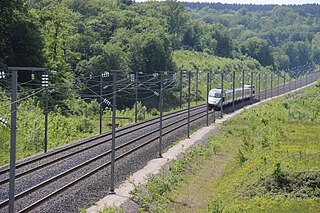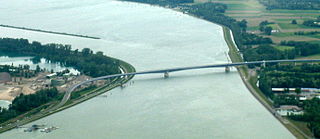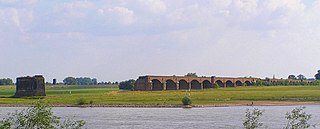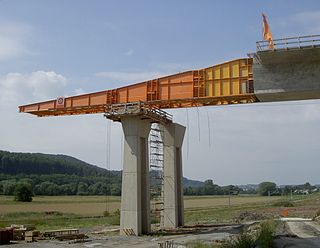
The TGV is France's intercity high-speed rail service, operated mainly by SNCF. SNCF worked on a high-speed rail network from 1966 to 1974 and presented the project to President Georges Pompidou who approved it. Originally designed as turbotrains to be powered by gas turbines, TGV prototypes evolved into electric trains with the 1973 oil crisis. In 1976 the SNCF ordered 87 high-speed trains from Alstom. Following the inaugural service between Paris and Lyon in 1981 on the LGV Sud-Est, the network, centered on Paris, has expanded to connect major cities across France and in neighbouring countries on a combination of high-speed and conventional lines. The TGV network in France carries about 110 million passengers a year.

Kehl is a city with around 38,000 inhabitants in the southwestern German state of Baden-Württemberg. It lies in the region of Baden on the Rhine River, at the confluence with the smaller Kinzig River, directly opposite the French and Alsatian city of Strasbourg. It is the third-largest city of the Ortenaukreis after Offenburg and Lahr/Schwarzwald.

The Ligne à Grande Vitesse Est européenne, typically shortened to LGV Est, is a French high-speed rail line that connects Vaires-sur-Marne and Vendenheim. The line halved the travel time between Paris and Strasbourg and provides fast services between Paris and the principal cities of Eastern France as well as Luxembourg and Germany. The LGV Est is a segment of the Main Line for Europe project to connect Paris with Budapest with high-speed rail service.

The Pierre Pflimlin Bridge is a 957-metre (3,140 ft) long motorway cantilever bridge over the river Rhine, with a main span measuring 205 metres (673 ft). It connects Germany and France, at Kehl and Strasbourg. It is named after Pierre Pflimlin, a former French prime minister, and was opened in 2002. It was funded by France, Germany and the European Union.

The Magistrale for Europe or Main Line for Europe is a Trans-European Transport Networks (TEN-T) project for the creation of a high-speed railway line between Paris and Bratislava, with a branch-off to Budapest. It was listed as TEN project No. 17 (Paris—Bratislava) by the European Commission in 1995, and is already under way.

The siege of Kehl was one of the opening moves of the French Rhineland campaign in the War of the Polish Succession, at the fortress town of Kehl in the upper Rhine River valley in the Holy Roman Empire. A large French army under the command of the Duke of Berwick besieged and captured the fortress, which was lightly garrisoned and in poor condition.

The siege of Kehl lasted from 26 October 1796 to 9 January 1797. Habsburg and Württemberg regulars numbering 40,000, under the command of Maximilian Anton Karl, Count Baillet de Latour, besieged and captured the French-controlled fortifications at the village of Kehl in the German state of Baden-Durlach. The fortifications at Kehl represented an important bridgehead crossing the Rhine to Strasbourg, an Alsatian city, a French Revolutionary stronghold. This battle was part of the Rhine Campaign of 1796, in the French Revolutionary War of the First Coalition.

France has a large network of high-speed rail lines. As of June 2021, the French high-speed rail network comprises 2,800 km (1,740 mi) of tracks, making it one of the largest in Europe and the world. As of early 2023, new lines are being constructed or planned. The first French high-speed railway, the LGV Sud-Est, linking the suburbs of Paris and Lyon, opened in 1981 and was at that time the only high-speed rail line in Europe.

The Duisburg–Hochfeld railway bridge spans the Rhine in the German city of Duisburg on the Duisburg-Ruhrort–Mönchengladbach line. The first bridge was built by the Rhenish Railway Company and put into operation at the end of 1873. It was replaced by a new bridge in 1927, which was badly damaged during the Second World War, but rebuilt and is still serves rail traffic between the Ruhr region and Aachen.

The Hindenburg Bridge was a railway bridge over the Rhine between Rüdesheim in the German state of Hesse and Bingen-Kempten state of Rhineland-Palatinate, named in 1918 after Field Marshal Paul von Hindenburg, later German President. The bridge was put in service in 1915, destroyed in the Second World War and never rebuilt.

The Wesel Railway Bridge was a bridge on the Haltern–Venlo railway, built as part of the Hamburg–Venlo railway by the Cologne-Minden Railway Company, and opened on 1 March 1874. The 1,950-metre (6,400 ft) long railway bridge at Wesel was the last Rhine bridge remaining in German hands during World War II.

The Waldshut–Koblenz Rhine Bridge is a single-track railway bridge on the Turgi–Koblenz–Waldshut railway, between Waldshut and Koblenz AG, crossing the Rhine and the border between Germany and Switzerland. It was the first railway bridge built over the Rhine below Lake Constance. It is the only major railway bridge over the Rhine, which is completely preserved in its original condition and is one of Europe's few lattice truss bridges. It is also one of the oldest railway bridges in the world.

The Old Rhine Bridge at Konstanz spans the Seerhein. It is a combined road and railway bridge. In addition to one track of the High Rhine Railway at kilometer 413.5, it carries the Konzilstraße, the road that connects the borough of Petershausen with the city centre. The road bridge carries two lanes into the city center and three lanes in the other direction. Additionally, there is a bicycle lane in both directions on the left and a sidewalk on the right. In the 19th century, distance markers were placed along the Rhine; they start counting kilometers at this bridge.

Incremental launch is a method in civil engineering of building a complete bridge deck from one abutment of the bridge only, manufacturing the superstructure of the bridge by sections to the other side. In current applications, the method is highly mechanised and uses pre-stressed concrete.

The Saverne Tunnel, also known as the Ernolsheim-lès-Saverne Tunnel, is a twin-bore 4-kilometre-long (2.5 mi), high-speed rail tunnel in western Bas-Rhin, France. It carries the LGV Est line of France's TGV high-speed rail network through the narrowest part of the Vosges mountain range, beneath Mont Saint-Michel and adjacent to the Saverne Pass. The tunnel consists of two bores, containing one rail track each, that are connected by passageways every 500 metres (1,600 ft). The LGV Est crosses the 270 m (890 ft) Haspelbaechel viaduct near the western end of the tunnel. The tunnel was excavated by a tunnel boring machine between November 2011 and February 2013. Civil engineering work on the tunnel ended in April 2014 and it opened with the rest of the second phase of the LGV Est on 3 July 2016. The total cost of the tunnel was approximately €200 million.

During the Battle of Kehl, a Republican French force under the direction of Jean Charles Abbatucci mounted an amphibious crossing of the Rhine River against a defending force of soldiers from the Swabian Circle. In this action of the War of the First Coalition, the French drove the Swabians from their positions in Kehl and subsequently controlled the bridgehead on both sides of the Rhine.

The Second Battle of Kehl occurred on 18 September 1796, when General Franz Petrasch's Austrian and Imperial troops stormed the French-held bridgehead over the Rhine river. The village of Kehl, which is now in the German state of Baden-Württemberg, was then part of Baden-Durlach. Across the river, Strasbourg, an Alsatian city, was a French Revolutionary stronghold. This battle was part of the Rhine Campaign of 1796, in the French Revolutionary War of the First Coalition.

The Hammer Bridge is a 220 metres (722 ft) long railway bridge on the Weser Valley line crossing the Geul valley a few hundred meters to the south of Hergenrath.

On 14 November 2015, a TGV train derailed in Eckwersheim, Alsace, France, while performing commissioning trials on the second phase of the LGV Est high-speed rail line, which was scheduled to open for commercial service five months later. The derailment resulted in 11 deaths and 42 injuries. It was the first fatal derailment in the history of the TGV and the third derailment since the TGV entered commercial service in 1981.

Mother Kinzig is a 1861 cast iron statue in the German city of Kehl. It represents a "beautiful, dreamy, and sexy", "marvelously pretty" nude woman, who has been called "the most beautiful girl of Kehl".
























